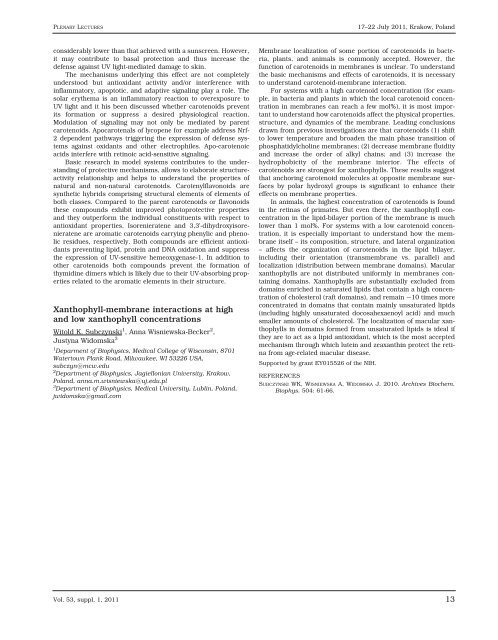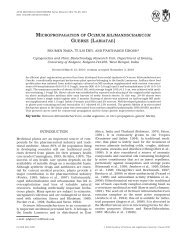ACTA BIOLOGICA CRACOVIENSIA
ACTA BIOLOGICA CRACOVIENSIA
ACTA BIOLOGICA CRACOVIENSIA
You also want an ePaper? Increase the reach of your titles
YUMPU automatically turns print PDFs into web optimized ePapers that Google loves.
PLENARY LECTURES<br />
considerably lower than that achieved with a sunscreen. However,<br />
it may contribute to basal protection and thus increase the<br />
defense against UV light-mediated damage to skin.<br />
The mechanisms underlying this effect are not completely<br />
understood but antioxidant activity and/or interference with<br />
inflammatory, apoptotic, and adaptive signaling play a role. The<br />
solar erythema is an inflammatory reaction to overexposure to<br />
UV light and it his been discussed whether carotenoids prevent<br />
its formation or suppress a desired physiological reaction.<br />
Modulation of signaling may not only be mediated by parent<br />
carotenoids. Apocarotenals of lycopene for example address Nrf-<br />
2 dependent pathways triggering the expression of defense systems<br />
against oxidants and other electrophiles. Apo-carotenoic<br />
acids interfere with retinoic acid-sensitive signaling.<br />
Basic research in model systems contributes to the understanding<br />
of protective mechanisms, allows to elaborate structureactivity<br />
relationship and helps to understand the properties of<br />
natural and non-natural carotenoids. Carotenylflavonoids are<br />
synthetic hybrids comprising structural elements of elements of<br />
both classes. Compared to the parent carotenoids or flavonoids<br />
these compounds exhibit improved photoprotective properties<br />
and they outperform the individual constituents with respect to<br />
antioxidant properties. Isorenieratene and 3,3'-dihydroxyisorenieratene<br />
are aromatic carotenoids carrying phenylic and phenolic<br />
residues, respectively. Both compounds are efficient antioxidants<br />
preventing lipid, protein and DNA oxidation and suppress<br />
the expression of UV-sensitive hemeoxygenase-1. In addition to<br />
other carotenoids both compounds prevent the formation of<br />
thymidine dimers which is likely due to their UV-absorbing properties<br />
related to the aromatic elements in their structure.<br />
Xanthophyll-membrane interactions at high<br />
and low xanthophyll concentrations<br />
Witold K. Subczynski1 , Anna Wisniewska-Becker2 ,<br />
Justyna Widomska 3<br />
1Deparment of Biophysics, Medical College of Wisconsin, 8701<br />
Watertown Plank Road, Milwaukee, WI 53226 USA,<br />
subczyn@mcw.edu<br />
2Department of Biophysics, Jagiellonian University, Krakow,<br />
Poland, anna.m.wisniewska@uj.edu.pl<br />
3Department of Biophysics, Medical University, Lublin, Poland,<br />
jwidomska@gmail.com<br />
Vol. 53, suppl. 1, 2011<br />
17–22 July 2011, Krakow, Poland<br />
Membrane localization of some portion of carotenoids in bacteria,<br />
plants, and animals is commonly accepted. However, the<br />
function of carotenoids in membranes is unclear. To understand<br />
the basic mechanisms and effects of carotenoids, it is necessary<br />
to understand carotenoid-membrane interaction.<br />
For systems with a high carotenoid concentration (for example,<br />
in bacteria and plants in which the local carotenoid concentration<br />
in membranes can reach a few mol%), it is most important<br />
to understand how carotenoids affect the physical properties,<br />
structure, and dynamics of the membrane. Leading conclusions<br />
drawn from previous investigations are that carotenoids (1) shift<br />
to lower temperature and broaden the main phase transition of<br />
phosphatidylcholine membranes; (2) decrease membrane fluidity<br />
and increase the order of alkyl chains; and (3) increase the<br />
hydrophobicity of the membrane interior. The effects of<br />
carotenoids are strongest for xanthophylls. These results suggest<br />
that anchoring carotenoid molecules at opposite membrane surfaces<br />
by polar hydroxyl groups is significant to enhance their<br />
effects on membrane properties.<br />
In animals, the highest concentration of carotenoids is found<br />
in the retinas of primates. But even there, the xanthophyll concentration<br />
in the lipid-bilayer portion of the membrane is much<br />
lower than 1 mol%. For systems with a low carotenoid concentration,<br />
it is especially important to understand how the membrane<br />
itself – its composition, structure, and lateral organization<br />
– affects the organization of carotenoids in the lipid bilayer,<br />
including their orientation (transmembrane vs. parallel) and<br />
localization (distribution between membrane domains). Macular<br />
xanthophylls are not distributed uniformly in membranes containing<br />
domains. Xanthophylls are substantially excluded from<br />
domains enriched in saturated lipids that contain a high concentration<br />
of cholesterol (raft domains), and remain ~10 times more<br />
concentrated in domains that contain mainly unsaturated lipids<br />
(including highly unsaturated docosahexaenoyl acid) and much<br />
smaller amounts of cholesterol. The localization of macular xanthophylls<br />
in domains formed from unsaturated lipids is ideal if<br />
they are to act as a lipid antioxidant, which is the most accepted<br />
mechanism through which lutein and zeaxanthin protect the retina<br />
from age-related macular disease.<br />
Supported by grant EY015526 of the NIH.<br />
REFERENCES<br />
SUBCZYNSKI WK, WISNIEWSKA A, WIDOMSKA J. 2010. Archives Biochem.<br />
Biophys. 504: 61-66.<br />
13












